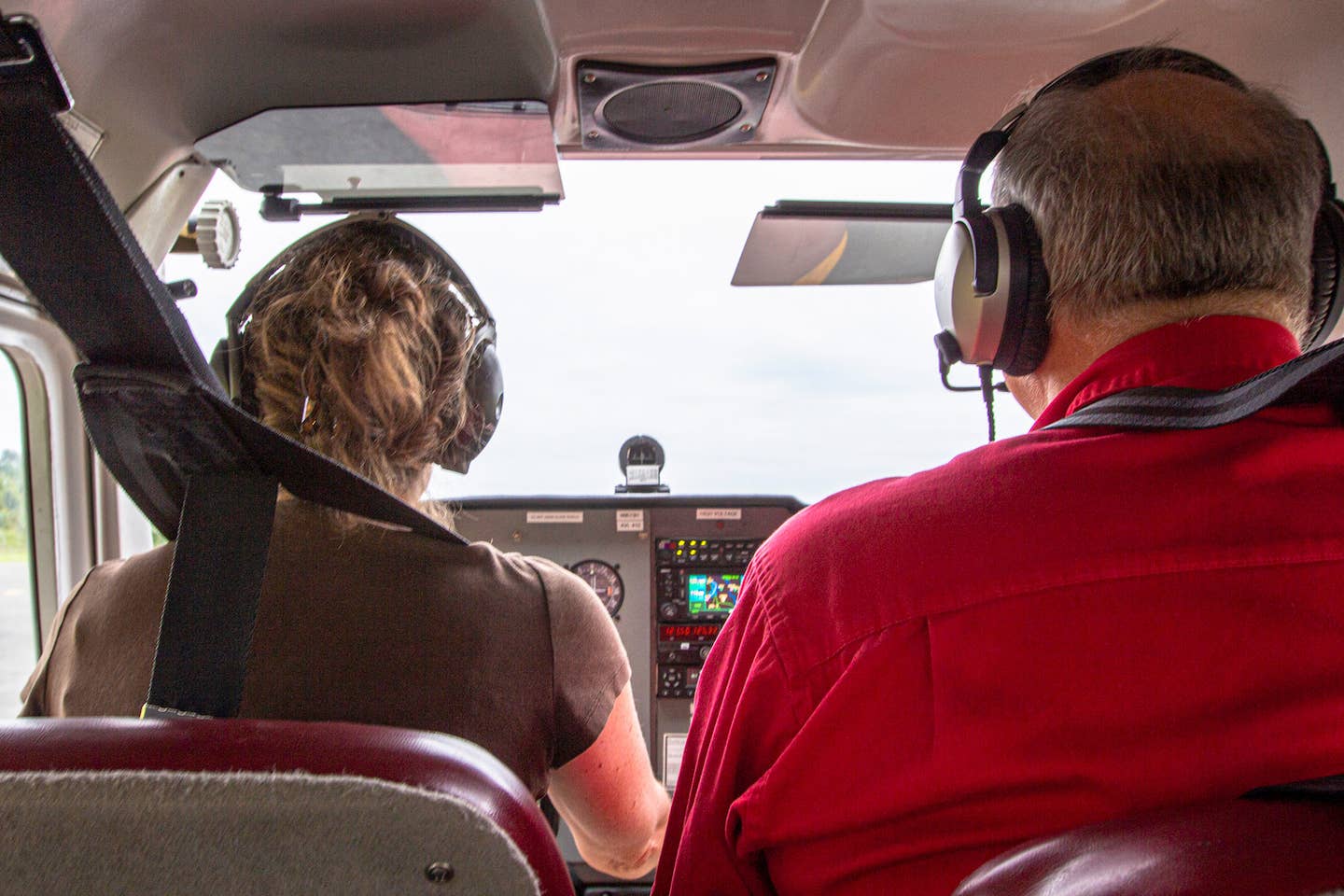How to Avoid Junk Instruction
Your relationship with your flight instructor is key. Here’s how to teach your instructor how to teach you and get the most out of your lesson.

If you don’t feel like you are getting much out of your flying, talk with your instructor. [Credit: Stephen Yeates]
Flight training can be overwhelming. The education is mental, physical, and to some extent emotional, and as it is non-compulsory sometimes it can feel a little on the masochistic side as you put yourself in this situation. The relationship with the flight instructor is key, as you will teach him or her what works best for you. In short, you teach us how to teach you.
The Process
Everytime a CFI teaches a lesson with a new learner, we have the opportunity to acquire a new perspective. When we introduce a concept or a maneuver, we develop more skill in its presentation, and depending on how the learner responds, we may adopt a different approach to the presentation.
I was many years into my CFI career when I encountered two private pilot candidates who needed to hold something in their hands to truly grasp the concepts presented. I had worked with my share of kinetic learners—they have to do the task to learn the task—and there was that one learner who processed knowledge using drill team dance moves—but the concept of a learner who needed to hold something was new to me. Both were having a difficult time learning airspace—holding the VFR sectional wasn't helping, they needed something in 3-D.
I had seen the plastic models of Class B, C, etc., but they were out of my price range so I resorted to paper mache with the idea of making the models myself. The last time I built anything from paper mache was in grade school, but I figured “desperate times” and all that.
Supplies were easy to come by. In Seattle, we're big on recycling, so it wasn't long before I had enough newspaper, empty coffee and cocoa canisters, and cardboard boxes for the project. One of my coworkers did a lot of crafting, so she supplied me with the glue and the paint—taking a VFR sectional to the craft supply store to pick out the exact color matches for the depiction of airspace. Each model has a placard with the visibility and cloud clearances for that airspace. I added capital letters B,C, D, E, and G cut out of sandpaper so the learner could get an extra tactile experience as they processed the information. It took about two weeks to construct models for each type of airspace. Do they look like something your kid would do for a science project? Yes. Do they work as intended? You betcha.
Low Time, Low Skill, Lowered Expectations
Over the weekend I watched an aircheck of a FAASTeam Sponsored CFI DPE SUPER-FORUM. The forum is an opportunity for CFIs and DPEs to share information about challenges they are seeing in the instructional world and brainstorm ideas on how to improve flight training and the testing process. One of the jarring takeaways from the forum was the statement that two-thirds of the CFIs who are actively instructing at this time do so for a year or less before moving on to other aviation jobs. This discussion was sparked by the statement that approximately 50 percent of first-time private pilot applicants were failing their check rides on the first try, followed by a discussion on ways to mitigate the situation.
One suggestion was that the CFIs who endorsed the applicant for the check ride would face punitive measures if the applicant failed. I think this would create an environment where few people would want to be CFIs, and those that did make the choice would be loath to provide endorsements for the practical test.
A few of the presenters noted that many of the low-time CFIs simply don't have the time to build the experience they need to be better pilots, much less instructors, and the learners they work with don't have the experience to realize they are being short-changed. Many of these learners will go on to be CFIs and repeat the cycle, providing what can best be described as “junk instruction.”
Similar to “junk sleep,” which is defined as sleep that is not optimized for maximal health and wellness benefits, junk instruction consists of trips out to the practice area, perhaps a dual cross-country or two, and laps in the pattern. It results in lots of hours in the logbook of both the learner and the CFI, but learning may not be taking place. Repetition is key for learning, but repetition without purpose is of low value—the only benefit may be an hour gained for the logbook. It is the same hour over and over again in pursuit of the 1,500 hours needed for the airlines.
Quality vs Quantity
It is becoming more common for airlines to lean toward applicants who have accrued time doing something other than flight instruction. Ferrying aircraft and charter operations hold value, as demonstrating the applicant's ability to operate in a crewed environment is key.
There is a great debate over quality hours over the quantity of hours—this has been in place since 2013 when the FAA created the restricted ATP certificate, also known as the “1,500 hour rule.” The rule requires pilots to have at least 1,500 hours total time to sit in the right seat of an airliner. There are lower hour exceptions made for military pilots—they qualify at 750 hours—and those trained under two-and-four-year degree programs can apply at 1,000 and 1,250 hours respectively. Prior to the R-ATP rule, pilots with commercial certificates and as little as 250 hours could qualify for a position at an airline.
The R-ATP rule was created in response to the crash of Colgan Air Flight 3407 in 2009. The Bombardier Q400 went down at night in Buffalo, New York, killing all 49 people on board. The National Transportation Safety Board and the FAA ruled the cause of the crash to be pilot error, as neither the captain or copilot noticed the aircraft was losing airspeed while on approach and took improper action when the aircraft entered a stall and subsequent spin.
The rule was created, so said its critics, to make the general public feel better about who was in the cockpit of the airliner. However, both the captain and copilot of Colgan 3407 had well over 1,500 hours total time and both held full ATP certificates. It was also determined that pilot fatigue also played a role in the accident, resulting in (positive) changes to rest requirements for pilots.
Are Your Hours Junk?
Just as junk sleep doesn't provide adequate rest, junk flight hours may not do much toward building skill or proficiency. If a pre-solo learner has two full pages of 'pattern work' in their logbook yet no solo has taken place it's time to get out of the pattern to review the fundamentals because flights consisting of repetitive laps in the pattern clearly aren't working.
If you don't feel like you are getting much out of your flying, talk with your instructor. Work with them to get a better understanding of each flight lesson before it begins. There are certain elements that make up each lesson, and if those elements are there and addressed, learning takes place.
Only Elephants Should Ingest Lemon Candy Corn Really
This mnemonic device covers the elements of each lesson. It stands for objective, equipment, schedule, instructor's actions, learner's actions, completion standards, common errors, and references.
The elements are easy to fill in:
- Today's objective is learning slow flight.
- The equipment we need is an airplane.
- The schedule calls for we will brief about 10 minutes, you do the preflight and we'll spent about an hour in the air, then another 10 minutes on the ground for debrief.
- My job as CFI is to explain the maneuver and demonstrate the maneuver.
- Your job is to listen, learn, and perform the maneuver.
- The completion standards are that you enter slow flight and keep the aircraft within 5 knots of stall speed per the airman certification standards and recover properly without the error of entering a stall or having the horn blaring through the maneuver, or poor rudder control or trying to steer with the yoke in a stall.
- For references, I am getting all this information out of the Pilot's Handbook of Aeronautical Knowledge and ACS.
At the conclusion of the lesson, determine if the mission was a success. You may find a greater sense of accomplishment and get more out of each flight when you know what you're striving for. And learning will take place.

Sign-up for newsletters & special offers!
Get the latest FLYING stories & special offers delivered directly to your inbox






